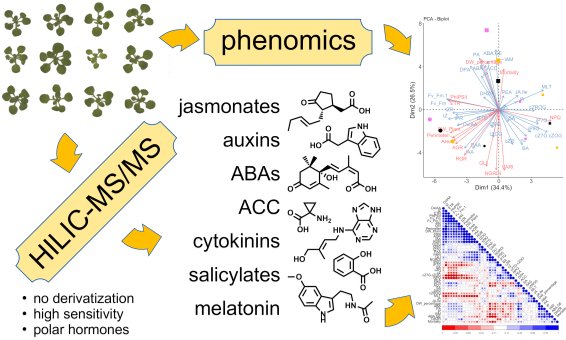Scientists design new procedure for studying plant-environment interactions
A new method for simple and fast analysis of plant hormones has been developed by scientists from CATRIN, Palacký University and the Olomouc Crop Research Institute. They have developed and validated a procedure that uses a less common type of chromatography (HILIC), which can analyse several different groups of hormones at once, without the need for complex sample preparation. Combining this method with large-scale plant phenotyping provided a new tool for studying plant-environment interactions. They published the results of their research in The Plant Journal.
Plant hormones, which influence almost every aspect of the plant life cycle and also control plant responses to the environment, are involved in complex signalling networks. These can be more easily deciphered through complex analytical methods capable of capturing information on several groups of plant hormones simultaneously. Previously used methods for this purpose were mostly based on reversed-phase (RP) liquid chromatography and detection by mass spectrometry. Hydrophilic interaction chromatography (HILIC) is an alternative chromatographic method that is increasingly being applied in the analysis of biological samples.

“That’s why we developed and validated the HILIC method for comprehensive analysis of plant hormones, including a rapid sample preparation procedure. It allows the screening of 45 different plant hormones. This method is faster and more efficient because it does not require derivatisation or fractionation, which are usually time-consuming steps in hormone analysis. In addition, the new approach is more sensitive and can detect even very small amounts of these growth regulators. However, this publication does not only discuss the new chromatographic method, but also highlights the great potential of linking it to phenotyping of plants exposed to a multifactorial combination of stresses to study plant interactions with the environment in which they are usually exposed to different types of stresses simultaneously. This will allow us to better understand how plants respond to stress conditions such as salinity or nutrient deficiency, which may have practical applications, for example, in agriculture to improve plant resistance,” said corresponding author of the paper, Petr Tarkowski.
He said the researchers also placed great emphasis on making the method consistent and reliable, factors that are often lacking in HILIC methods.
In the paper, the authors demonstrated the potential of the method with a case study that combined hormone analysis with high-throughput non-invasive phenotyping to examine the responses of three Arabidopsis ecotypes to salinity, low nutrient availability, and a combination of the two. The results suggest that the simultaneous determination of several groups of plant hormones could be a valuable tool for a deeper understanding of the networks, interactions and dynamics of plant hormones in complex plant-environment interactions.

